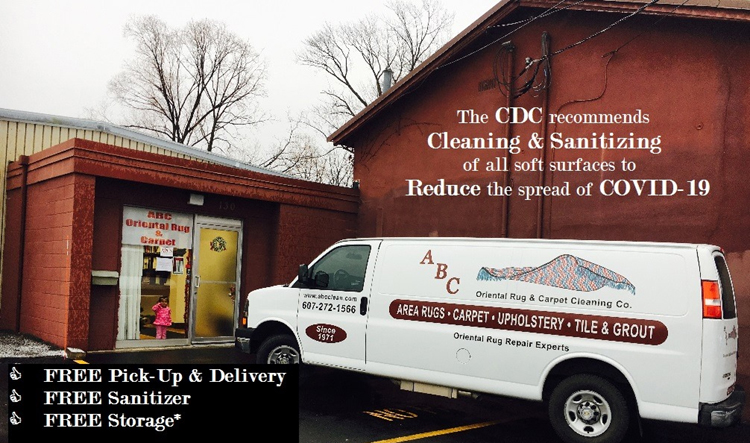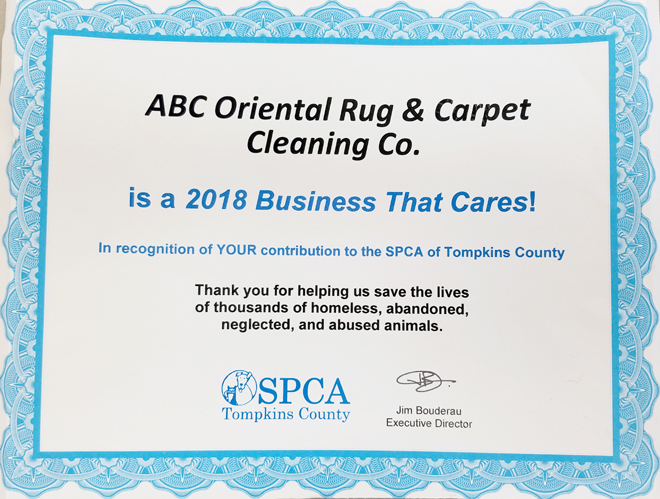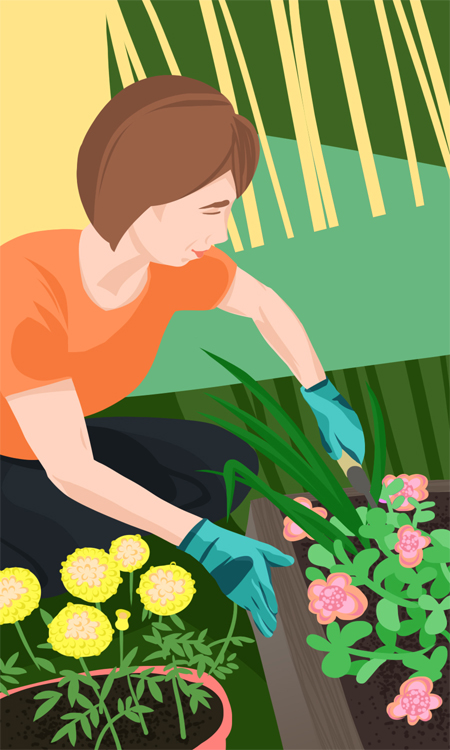ABC MONTHLY NEWSLETTER
May 2020
Welcome to Our Monthly Newsletter!
We hope you will enjoy this month's articles.
This month's topics are:
COVID-19 PANDEMIC
AREA RUGS
HEALTH
CONSIGNMENT RUGS FOR SALE REMINDER
If there is a topic you would like us to cover in one of our upcoming newsletters, please call us at
607-272-1566
or contact us by clicking here.
GREAT NEWS!
GOT QUESTIONS?
NOW YOU CAN TEXT US at
607-272-1566
COVID-19 FAQs UPDATE
As we head into another month of isolation and uncertainty and as we learn more about the COVID-19 pandemic and how it is spread, we find we are beginning to get answers to some of our most pressing questions as more scientific data becomes available.
We have included answers from reliable sources to some of these questions with the caveat that as data does become more available the answers are subject to change.
Can My Pet Become Infected With the Virus?
On April 22, 2020, the CDC, the USDA, and the NVSL (National Veterinary Services Laboratories) announced the first confirmed cases of the SARS-CoV-2 (COVID-19 virus) infection in 2 pet cats.The 2 cats had only mild respiratory illness and are expected to make a full recovery. They live in 2 separate areas of New York State. This was the first evidence in the US in which a household pet had been infected.
It is interesting to note that in the home of the first cat tested, no one in the household was confirmed to have COVID-19. It is possible the virus may have been transmitted to the cat by an asymptomatic individual in the home or one who was mildly ill or perhaps through contact with an infected person outside the home.
The owner of the second cat had tested positive for COVID-19 before the cat was tested. There was another cat in the home but it has shown no signs of illness.
The only other 2 animals in the US reported to have COVID-19 are a tiger on April 4th and a lion on April 15th. There have been a few animals in other parts of the world infected, but they were known to have had close contact with someone with COVID-19.
Can My Pet Transmit the Infection to Me Or To Other Pets Or To Members of My Household Or To Other Animals?
At this point in time, there is no evidence that pets play any role in spreading the virus in the US.
Routine testing of animals is not recommended at this time, especially because the welfare of companion animals may be compromised. There is simply not enough data yet.
You can check for confirmed cases of animals with tested for COVID-19 on this site from the USDA.
Until more data is available, the CDC recommends the following:
- Do not let pets interact with people or other animals outside the household.
- Keep cats indoors when possible to prevent them from interacting with other animals or people.
- Walk dogs on a leash, maintaining at least 6 feet from other people and animals.
- Avoid dog parks or public places where a large number of people and dogs gather.
- If you are sick with COVID-19 (either suspected or confirmed by a test), restrict contact with your pets and other animals, just like you would around other people. Avoid contact with your pet, including petting, snuggling, being kissed or licked, and sharing food or bedding. There may be a possibility that coronavirus droplets from a cough or sneeze could remain on the fur of pets for a period of time.
- When possible, have another member of your household care for your pets while you are sick.
- If you must care for your pet or be around animals while you are sick, wear a cloth face covering and wash your hands before and after you interact with them.
Should I Not Let My Dog Lick My Hands After I Use Sanitizer?
There is a false warning making the rounds that sanitizer has the same ingredients as antifreeze which is toxic to dogs. So you should not let dogs lick your hands. Not true!
The misconception comes from the misunderstanding of the properties of 2 chemicals, propylene glycol and ethyl glycol.
Propylene glycol is used in sanitizers to hold in moisture to prevent the hands from drying out. It is also found in some antifreeze. This is when it replaces ethylene glycol, the usual active ingredient, to make the antifreeze more environmentally friendly and to lower its general toxicity.
Ethylene glycol is indeed toxic to dogs as well as to humans. Propylene glycol is not at all toxic. The extra carbon atom in propylene glycol is why this is the case.
Thus, no worries about your dog licking your hands after you have used sanitizer. It may be more important to know what your dog had been licking before he or she licked your hands!
Is It Safe To Go To
The Grocery Store?
The short answer is to try to minimize visits to any store because of the risk of being around other people.
Try to maintain at least a 3 to 6 foot buffer around yourself and others.
Use self-checkout when possible and hand sanitizer when you are finished.
Wash your hands with soap and water as soon as possible.
Are Masks and/or Gloves Necessary at the Grocery Store or any Store?
A big change has happened in regard to using face masks in any public place such as a grocery store. In many areas, they are required.
The CDC does not recommend wearing N95 respirator masks or surgical masks, as these must be reserved for the shortage of protective equipment facing health care workers.
We have all been cautioned that the wearing of cloth masks is not for our own protection but to protect others from us should we cough or sneeze or be without any symptoms but still be able to spread the virus.
Gloves are another matter. They will not help if you touch your eyes, nose or mouth with them. If you do use gloves, make sure they are disposable and throw them away before getting into your car or as soon as you get home. Make sure to wash your hands with soap and water as soon as possible after you take your gloves off.
In reality, you probably do not need gloves as long as you wash your hands before and after your trip and don't touch your face with your hands. If you need to use your phone in the store, make sure to clean it when you get home.
Are Disinfectant Wipes Necessary When Leaving the Home and If So, What Do We Use Them For? For more
COVID-19 updates such as using disinfectant wipes, paying with credit cards, cash, and checks, using senior shopping hours, transmission of the virus from paper, plastic bags, cardboard, food, raw fruits and vegetables, and clothes in the laundry, please continue reading here.
SHAG RUGS
The shag rugs we see today are direct descendants of the shag carpeting that was all the rage in homes of the 1970s. There is a large variety of shag area rugs available now which come in all shapes, sizes, and materials.
Who
wouldn't like the addition of a comfy, furry, cozy shag rug in their
home? But, buyer beware, shag rugs may be a great decorative idea, but
the cleaning challenges for the homeowner, and the professional rug
cleaner as well, can quickly turn that idea into a terrible household
reality!
TYPES of WOOL SHAG RUGS?
CHUNKY WOOL SHAG RUGS
Chunky wool shag rugs are woven in both Greece (Flokatis) and Morocco.
The Flokatis usually come in solid, off-white natural colors and resemble big sheepdogs on the floor.
The Moroccan rugs look similar to the Flokatis but tend to have geometric designs rather than the solid color creations of the Greeks.
CUSTOM WOOL SHAG RUGS
The custom wool shag rugs we see now range from dyed to undyed, from spun to felted, and from thin strands to big needle shapes.
Some of these custom wool creations consist of wool strands tufted into a cotton canvas foundation, often utilizing latex to hold them together.
CHALLENGES OF CLEANING WOOL SHAG RUGS
Shedding and Pilling
The wool yarn used in these rugs is made from short wool fibers (known as staple fibers). These are spun together to produce a longer shag length. Thus, they tend to pull apart with use. Rugs made from the looser, chunkier wool often shed for years.
Pilling can occur on tighter-spun fibers, somewhat like on the elbows of wool sweaters after much use. Although a washing can sometimes lessen the shedding, in many cases the shedding will continue for the life of the rug.
Tough to Vacuum
Standard vacuum cleaners will not work on these rugs. On large ones the DIY homeowner may have to groom with a horsehair brush to pick up surface matter and use a crevice tool to pull up the rest of the debris that gets embedded into the foundation.
It might be possible to hang the large rugs outside and use a leaf blower to beat and blow out the dirt and grit. Smaller rugs can be taken outside to shake them free of loose particulate matter.
These types of shag rugs should be periodically taken to a professional rug washing plant where tumblers and compressed air tools can help remove soil as well as fluff up the fibers.
Tough to Wash and Decontaminate
Wool shag rugs will become extremely heavy when they are wet. Agitation is a problem because of the tendency to lose fibers and because the wool rows do not easily open up to release soil from the base. This again should be the job for rug washing plants where special tools are available.
Shag rugs with urine contamination will often need extended soaking to remove the contaminants. (Again, a job for the professional rug washer.)
If the homeowner is tempted to wash smaller rugs in a commercial washer, the alkalinity and the temperature must be watched carefully because these rugs can yellow and shrink if improperly laundered.
Prone to Moths and Carpet Beetles
The wool of this type of shag rugs can be very susceptible to moths and carpet beetles because of the difficulty of vacuuming them. The rug foundations are rarely reached by a vacuum. Bugs like dark, undisturbed places with a food source and the fibers deep at the base of the rugs are a perfect home for them.
LEATHER STRIP RUGS and COTTON RAG RUGS
Please continue reading here for information on more types of shag rugs and the challenges they represent to the homeowner, complete with photos.
SALMON
Salmon is a fish we all know. But are you aware that it is not an individual species of fish? Actually there are 2 main divisions --Atlantic and Pacific. The Atlantic fish has just one main species, while the Pacific salmon has seven.
ATLANTIC SALMON
These are large fish found in the northern Atlantic Ocean weighing 8-12 pounds when fully grown. Unlike the other salmon species, they have evolved a non-migratory life cycle.
Their meat tastes very mild. It is usually cheaper than other types because nearly all of the Atlantic variety commercially available today is farmed, not wild-caught.
Wild populations of Atlantic salmon were once abundant throughout the northern Atlantic. Lake Ontario was their home. Unfortunately, by 1900 their population was almost completely extinct due to the combination of climate change, human colonization, habitat destruction, and overfishing.
While there are still wild Atlantic salmon alive and swimming, their capture is strictly regulated. Thus, fish farms have come forward to fill this void.
PACIFIC SALMON
Five main species of Pacific salmon are found in the Northern Pacific waters of the US and Canada. They are the Chinook, Chum, Coho, Pink, and Sockeye. Two other species, the Masu and Amago occur only in Asia.
NORTHERN PACIFIC SALMON
Chinook (King) (Blackmouth)
These are the largest of the Pacific salmons, weighing between 20 and 135 pounds. Salmon is valued for its fat content and the Chinook has the most fat of the salmon species, making them of value to chefs and also quite pricey due to their general rarity among fish. Chinook salmon has a flavor much like smoked salmon.
Chum (Dog) (Keta) (Calico)
This species of salmon is lower in fat and quite small. Its roe is the most valued of the other species because of its size and flavor and its use in sushi rolls. It is sometimes marketed as Silverbrite Salmon.
Coho (Silver)
The
Coho salmon are roughly 20 pounds in size, a little cheaper, but still
fat-filled. The Coho has a mild but distinctive flavor. It is most
widely available in the fall season.
Pink (Humpback)
This is a very delicate and pale fish with a rather bland taste. It is low in fat.
Sockeye (Red)
This species is a medium-sized fish with a deep, natural color. It is lower in fat, but still high enough to give good flavor.
FARM-RAISED vs WILD-CAUGHT SALMON
No matter what type of salmon you may choose to eat, it is important to know whether your salmon has been farm raised or wild caught. This is not for culinary purposes but rather for health ones.
FARM RAISED SALMON
Here are some reasons why farm-raised salmon should be avoided:
For further information on farm-raised vs wild-caught salmon, as well as tips on what consumers can do to purchase the healthiest salmon, please continue reading here.
MAY SPECIALS
Please check our website and our Facebook page to keep up to date during these uncertain COVID-19 times.
We will continue to offer:
- Specials from MARCH 2020
- FREE SANITIZER with every cleaning,
- FREE PICKUP and DELIVERY
- 3 months FREE STORAGE on items brought to our plant after payment
Please call or text our office at
607-272-1566
for details!

THANK YOU!! WE LOOK FORWARD TO CONTINUING TO SERVE YOUR TEXTILE CLEANING AND REPAIR NEEDS!
Get New Posts Right To Your Inbox!
Get our monthly newsletter, just like this one, delivered right to your inbox each day. Just sign up and we will send you the best new articles and videos as they become available.
Your email address will NEVER be spammed, sold, or shared. You are welcome to unsubscribe at any time with the link in the email.
"The Cleanest Clean You've Ever Seen."
by
ABC Oriental Rug & Carpet Cleaning Co.
130 Cecil Malone Drive Ithaca, NY 14850
607-272-1566

ABC
Carpet & Rug
Spotting Guide

ABC Oriental Rug & Carpet Cleaning Co. has been family-owned and operated in Ithaca and surrounding areas for more than 49 years.
Our company is a reflection of our family name and pride.
Please Like us on Facebook!
for more information and to find out what we are doing at our business and in the community!
Stay Connected!
Links to Our Services
Allergy Cleaning
Area Rug Cleaning
Oriental Rug Cleaning
Rug Hand & Machine Repair
Upholstered Furniture Cleaning
Tile & Grout Cleaning & Sealing
We are proud sponsors of the SPCA of Tompkins CO:

Newsletter Archives


